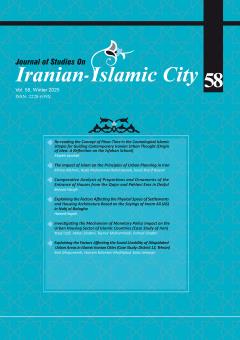-
-
-
Open Access Article
1 - The comparative study of Arabian-Islamic Urban pattern with Iranian-Islamic Urban pattern (case study: Khartoum and shiraz)
علی احمدیان کیسمی -
Open Access Article
2 - Analysis of cemeteries organizing in Isfahan city from the perspective of the Islamic Iranian city pattern
Asghar Montazer alghaeem Fardin Koshki -
Open Access Article
3 - Elucidation of the physical patterns of contemporary housing based on the contextual architecture in Kashan; Case study: Selected historical houses of the Qajar dynasty
Hossein kalantari Seyed Amir nezam dost Ali yaran -
Open Access Article
4 - Model of meaning relationship of "High quality public places" from Islamic-Iranian thought perspective
Mohsen Rafieian Mojtaba Rafieian Mohamadreza Bemanian -
Open Access Article
5 - Comparing the Efficiency of Sustainable Urban Economy Models on Local Development (Case study: District 10 of Tehran)
Zohreh Tajik Seyed Mosa Mosavi Farzaneh Salami -
Open Access Article
6 - Reading the meaning of mandala in the pattern of Behnam and Qadaki Qajar houses of Tabriz
sara pourmokhtar Mohammadreza pakdelfard Hassan Sattari -
Open Access Article
7 - The application of the concept of peace in the contemporary houses of Kerman )Understanding the different aspects of the formation of peace in two apartment and independent models with a yard(
Motahareh Eslami Mahmoodabadi Yaghoob Peyvastehgar Aliakbar Heidari -
Open Access Article
8 - Introducing the Transcendent Perceptual Process In order to perceived the Aesthetic Quality of Space (Combining the Viewpoints of New Sciences and Mulla Sadra's Transcendent Theosophy)
sara daneshmand Kaveh Fattahi -
Open Access Article
9 - Studying the Historical Evolution of the Basic Pattern in the Architecture of the Ancient Period and Iranian Tradition
Farshad Hatami Bargh Behrouz Mansouri Sayyed Mostafa Mokhtabad Amrei Leila Zare
List of Articles الگو
-
The rights to this website are owned by the Raimag Press Management System.
Copyright © 2017-2025


